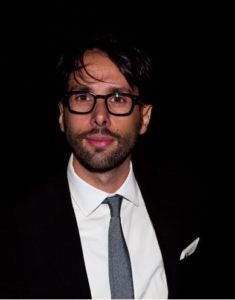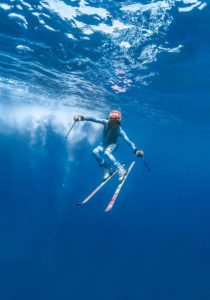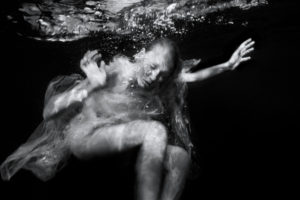Art is a way of telling the world through the creativity of the intellect. Man creates the world, but creation and reproduction are not the same thing: in fact, if the artist creates the world, the artisan reproduces it. Art is therefore not what the world is to put it as Karl Kraus, it is not a matter of taste, but of bypassing horizons, accomplishing something new. In this sense the interdisciplinary artist Giuseppe La Spada inspired by nature, poetry and sound, and always interested in environmental issues, tries to operate as nature does, reproducing its activity with digital techniques and photography. The protagonist of many works by the versatile Giuseppe La Spada is water, an element used as a pretext to talk about the Man-Nature relationship, reflecting on what lies beneath the surface, bringing out the unspeakable that acquires consistency in a timelessness suspended between sound and sign.
La Spada, as a photographer and video-artist, is a craftsman who tells something that can already be in our head, an explorer of depth, a sensitizing ideologue, an artist certainly conceptual but far from the aesthetics of disgust, in the wake of Art and Language movement born in the seventies. In fact, photography is not art but craftsmanship, technology and in the digital camera era this definition takes on an even stronger value.
La Spada has exhibited his works in Europe, America and Asia, where he received several awards, including the Webby Awards won in 2007 with an online project linked to ecology. In 2018 he participated in the Idesign exhibition, Manifesta 12 Collateral in Palermo with Fluctus, a huge plastic installation. In the same year, his work is also exhibited in the Re-Use exhibition, among artists such as Man Ray, Duchamp, Manzoni, Christo, Pistoletto, Damien Hirst. He currently lives and works in Milan: in 2017 he presented the installation Shizen no Koe at the Festival for the Earth at the Oceanographic Museum of Monaco, and has recently developed the social project We are drops which aims to create a new awareness in the new generations and especially in children.
How can you best express yourself? Through photography, digital art, video-art or installations?
When I was a boy reading Kandinsky “Spiritual in the Art”, I heard about a total work, this thing marked me forever, for me the best is to use all possible means, trying to give them a proper weight and dramaturgy. Every single element has a specific task, just like in an orchestra. Photography undoubtedly comes first, both as a synthesis act and as a fruition, therefore it is often the engagement to the other levels of reading especially today on social networks.
What do you think is the purpose of art today?
In this scenario where the scarce appeal of religions and politics, the speed and technological saturation reign, Art, today more than ever, is called to lead, to inspire the changes necessary for the survival of ourselves and of the planet. A new social architecture can be born thanks to shared thought, art is a fundamental driver.
Why, among all the elements of nature, did you choose to focus more on water?
Water for me is everything. Together with the air it is the element of necessity in both physical and spiritual sense, the intrauterine return, the mystical dive, the iridescent and ductile element par excellence. If we Understand water perhaps we will be able to understand the secret of life, of the eternal becoming.
Can you tell us something about the social project We are drops?
We are drops was conceived essentially after having realized that the only possible solution to combat pollution is to
create a new awareness in the new generations and especially in children. Behaviors can change by instilling love and protection against nature and giving tools for understanding problems. Children are much
more attentive than us and connected to nature.
In reference to your project, do you think art must also have an educational role, raise awareness of important issues?
Absolutely. It must compensate and accelerate social processes. Get out of certain elite ranks and meet people’s hearts. It must be a seismograph that monitors and restores the weight and rigor of certain lost values. The problems are almost all of a cultural nature, we cannot solve them by adopting the same strategies that generated them.
Does technique or experience matter more in the photographic experience?
I believe the intention is the sacred fire behind the desire to materialize and visualize. Today the project counts, the technique definitely becomes a consequence of the experience and it is an unavoidable condition, but the true depth gives the research in a holistic sense, many images of experience or technique often do not reach the final user.
Which work gave you most satisfaction?
I believe every job is an important part of the journey. Often the works coincide with the meetings, and this gave me the opportunity to meet extraordinary people. Having to make a choice, the answer is certainly linked to the meeting with the teacher and composer Ryuichi Sakamoto. A very important person for me, my life would be completely different without this encounter. Having the honor of collaborating with a master like him is a constant reference also in the absence. His depth of vision and intent has changed me forever. My work on Nature is the child of this encounter.
Why, as you also said, is it important to return to the “warmth of manual skill” in an age where digital art, together with conceptual art, is increasingly predominant?
Because we are losing the human part, compared to the more material part and in this unbridled race to technology, we are losing the thermal level of thought to artificial intelligence, which is why I always force myself to use digital in a “hot” way, never ending in itself.
Which personalities inspire you particularly?
I have already spoken about Sakamoto, then many poets, artists, directors, mystics, Tarkowskij and Josef Beuys, above all. I believe that the biographies of the great men of the past can give very interesting ideas, decoding the keys to their way of creating, imagining how they would behave today, going into resonance with their thinking
for me goes beyond mere inspiration.
Kandinskij transformed his painting into sound events, elaborating a harmonic theory of color; can we say that you, using for example the music of Sakamoto and Fennesz, want to fathom the emotionality and the interiority of a dormant world and of the human being in relation to the environment in which he lives?
For more than ten years the primary objective for me has been to reconnect and make people understand the relationship between man and nature, words are often not enough and different paths are needed. The emotional dart of synaesthesia, sound image, probably comes deeper than a text or data on environmental issues, I spent many years looking for these emotional keys. The contemporary man has an extreme need to recover the relationship with what is more than a place that hosts us.
Any upcoming commitments?
They are all linked to three words I love: Art, Spirituality, Sustainability and of course the element of Water.
Info:
 Giuseppe La Spada’s photo portrait
Giuseppe La Spada’s photo portrait
 Giuseppe La Spada, Federica Brignone. Traiettorie Liquide, 2018
Giuseppe La Spada, Federica Brignone. Traiettorie Liquide, 2018
 Giuseppe La Spada, Falling down, 2017, 105x70cm, Fine Art Inkjet Print mounted on Ddbond, from the series In a changing Sea Falling
Giuseppe La Spada, Falling down, 2017, 105x70cm, Fine Art Inkjet Print mounted on Ddbond, from the series In a changing Sea Falling
 Giuseppe La Spada, Collapsing series, 2015
Giuseppe La Spada, Collapsing series, 2015
Journalist, blogger and social media editor from Campania. i graduated in literature and philology and I gained a master in art and organization of cultural events. I love cinema, art, music, literature, especially Russian, French and Italian. I read a lot, both narrative and non-fiction. I share Picasso’s thoughts on art: “Art helps us to recognize the truth”.






NO COMMENT